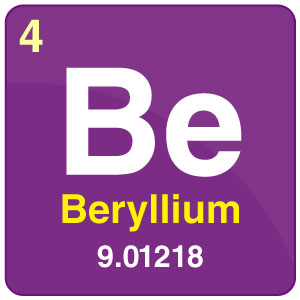
| Symbol | Be |
| Atomic Number | 4 |
| Atomic Mass | 9.01218 g.mol-1 |
| Discovered by | Nicholas Louis Vauquelin |

What is Beryllium?
- Beryllium is an element with an atomic number of 4 in the periodic table.
- It is a bivalent and highly toxic element.
- The element has one of the highest melting points among the light metals.
- Beryllium exists in 30 different minerals, among which bertrandite, beryl, chrysoberyl, and phenacite are the most important.
Table of Content
- Chemical data of Beryllium
- Properties of Beryllium
- Points of Distinction between Beryllium and other alkaline earth metals
- Uses of Beryllium
- Certain Facts About Beryllium
- FAQs
Chemical Data of Beryllium
| Group | 2 | Melting point | 1287°C, 2349°F, 1560 K |
| Period | 2 | Boiling point | 2468°C, 4474°F, 2741 K |
| Block | s | Density (g cm−3) | 1.85 |
| Atomic number | 4 | Relative atomic mass | 9.012 |
| State at 20°C | Solid | Key isotopes | 9Be |
| Electron configuration | [He] 2s2 | CAS number | 7440-41-7 |
| ChemSpider ID | 4573986 | ChemSpider is a free chemical structure database | |
Properties of Beryllium
- It is non-magnetic, holds excellent thermal conductivity and resists attack by concentrated nitric acid.
- Beryllium resists oxidation when exposed to air at standard temperature and pressure.
- It is found in 30 different minerals of which bertrandite, phenakite, and Beryl are the most important.
- Beryllium content in the ground can pass into the plants grown on it when it is in a soluble form.
Points of Distinction between Beryllium and other alkaline earth metals
- Beryllium is very hard while the other members of the family are comparatively soft.
- Beryllium reacts with oxygen only at very high temperature while the rest of the members combine upon heating.
- Beryllium oxide (BeO) is of amphoteric nature.
- Compounds of beryllium are mostly covalent because of the high positive charge density on Be2+ ion and polarising power.
- Except for beryllium the alkaline earth metals react with hydrogen upon heating to form metal hydrides
- Beryllium does not liberate hydrogen from dilute acid readily while other alkaline earth metals evolved hydrogen.
- Beryllium does not react with water under any conditions while other alkaline earth metals do react upon heating.
Uses of Beryllium
- Beryllium is used as an alloying agent.
- It possesses high strength, non-magnetic properties, better resistance, and dimensionally stable over a significant range of temperature.
- Beryllium fused with copper forms alloys which are used in defence and aerospace industries is a typical application of Beryllium.
Certain Facts About Beryllium
- Aquamarine and emerald are the most precious forms of beryl. Beryl is the mineral form of beryllium aluminium cyclosilicate.
- X-ray detection diagnostic uses of Beryllium as it could pass through latter.
Frequently Asked Questions- FAQs
1. What do they use beryllium for?.
Beryllium is used as an alloying agent. It is used alloys with copper or nickel to make gyroscopes, springs, electrical contacts, spot-welding electrodes and non-sparking tools. Beryllium fused with copper forms alloys which are used in defence and aerospace industries.
2. Is beryllium harmful to humans?
Beryllium is known as a cancer causing substance. Direct contact with beryllium fumes or dust may injure the exposed areas of the body, such as the eyes or the skin.
3. Where is beryllium found?
Beryllium is found in 30 different minerals of which bertrandite, phenakite, and Beryl are the most important. It is found in the Earth’s crust and mostly in igneous (volcanic) rocks. Most of the world’s beryllium is mined and extracted in the United States and Russia with the state of Utah supplying nearly two-thirds of the world’s beryllium production.
4. Is beryllium used in cell phones?
Beryllium fused with copper forms alloys which are used in the manufacture of telecommunications infrastructure equipment, computers and cellular phones.
5. What reacts with beryllium?
Beryllium reacts with oxygen at a very high temperature (above 600℃) form beryllium oxide.
2Be + O2 → 2BeO

Comments